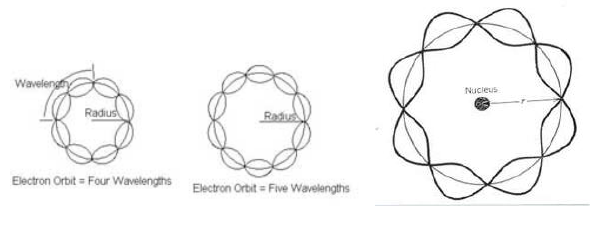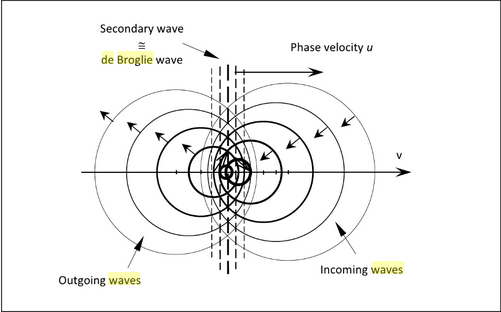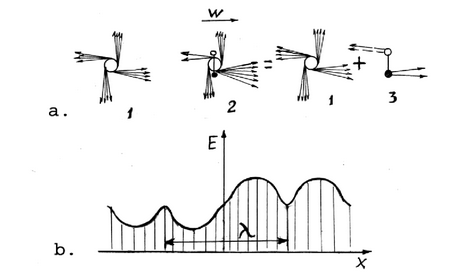Introduction
For a long time, physicians have proved that light has wavelike properties. In 1932, a young physicist, Louis de Broglie, said that most particles also exhibit the same property (NCS Pearson 5-6). From his assessment, he believed that most electrons and protons (among other types of particles) have unique wavelength properties (Reading Feynman Organization 5). This assessment was the basis for the development of de Broglie waves because they demonstrate the wave-particle duality of matter (electrons acting as particles and waves) (NCS Pearson 5-6). Physicians who have investigated de Broglie waves believe they are a creation of particles revolving around a nucleus as shown below (Tangient LLC 3).

The waves have a specific energy, frequency and wavelength. The knowledge conveyed by the understanding of de Broglie waves has improved our understanding of the physical nature of the atomic scale. However, some people have different conceptions of the same information. Indeed, experts have differing views regarding the physical state of these waves. While some of them treat the “wave element” as the fundamental nature of matter waves, others believe its fundamental nature to be the “particle element” (Kubel 62-63). Such debates have emerged in different theories, such as the hidden variable theory, which treats both elements of the de Broglie wave distinctively (Kolessin 6-8). To clarify some of these issues, this paper explains the hypothesis underlying the conception of de Broglie waves, investigates the nature of de Broglie waves, and highlights the principles surrounding the generation of the waves.
The de Broglie Hypothesis
Louis de Broglie supported his views of de Broglie waves by proving there is a relationship between a particle’s wavelength and its momentum (Kubel 62-63). In proving this relationship, de Broglie (cited in Reading Feynman Organization 6) said,
“When I conceived the first basic ideas of wave mechanics in 1923–24, I was guided by the aim to perform a real physical synthesis, valid for all particles, of the coexistence of the wave and the corpuscular aspects that Einstein had introduced for photons in his theory of light quanta in 1905” (Reading Feynman Organization 6).
He supported the above statement through the Planck constant. The equation (/| = h/p) embodies this statement, where /| is the wavelength, h is the Planck constant, and p is the momentum. This hypothesis is true for all types of matter because physicists have proved that their elements contain both wavelengths and momentum (Reading Feynman Organization 6).
Nature of de Broglie Waves
Scientists often use the term “de Broglie waves” interchangeably with “matter waves” (Reading Feynman Organization 6). As shown in this paper, the wavelength is often indirectly proportional to the momentum of the particles. The wavelength travels with phase velocity denoted by (u), where UV = c2 (Kubel 61). In this equation, ‘u’ is greater than ‘c.’ Here, outgoing and incoming spherical waves interlock to form a secondary wave. A secondary wave in an electron has the following characteristics

The diagram above illustrates the interaction between outgoing and incoming waves. The interaction causes spherical waves, which move with a constant velocity (v). Each incoming wave has a nucleus (center), which, when in motion, moves the center of the other wave towards the right (Kubel 62). The ingoing arrows (in the diagram above) show this fact. After passing the nucleus, these waves become outgoing waves. The waves that are the farthest from the center have the largest radius because they propagate the farthest (Kubel 62). The opposite is true because the rightward incoming waves have the largest radius because their centers arrive at the nucleus point latest (Kubel 62).
Generation of de Broglie Waves
De Broglie wave generation occurs through the accelerated motion of matter particles through an ether process (Kolessin 7). The diagram below shows a scheme of the ether process

According to the diagram above, the wave formation process occurs in two steps (denoted by steps ‘a’ and ‘b’). The first step has only three phases. The first phase (denoted by number 1) shows matter particle at rest. The second phase shows the matter particle in accelerated motion (Kolessin 7). The second step (b) shows an asymmetry of the electric vector of a de Broglie wave (E). Evenly distributed polarized chains of disposed sheaves characterize the resting state. In an accelerated motion, newly formed polarized chains replace old chains and increase their density (Kolessin 7). In this state, opposite forces are charging, but pulsating together. This movement accentuates the sense of de Broglie waves because two opposite forces, oriented in opposite directions, characterize them. The asymmetry in the disposition of the electric vector is the natural result of this process.
Summary
Although this report has explained the background and formation of de Broglie waves, it abstractly highlights its contributions to our understanding of wave mechanics. From this analysis, it is difficult to comprehend the physical state of de Broglie waves beyond the specifics of scientific inquiry. Nonetheless, this report helps us to understand the properties and behavior of some electrons. This knowledge could help us to promote advancements in laser technology, computer technology, and other fields of physics.
Works Cited
Kolessin, Rangel. Essence of Nature, New York, NY: Lulu.com, 2013. Print.
Kubel, Holger. Behind Fundamental Physics, New York, NY: Lulu.com, 2013. Print.
NCS Pearson. Wave Particle Duality. June. 2015. Web. February. 2016. Web.
Reading Feynman Organization. Quantum math: the rules – all of them!2015. Web.
Tangient LLC. Louis de Broglie. 2015. Web.